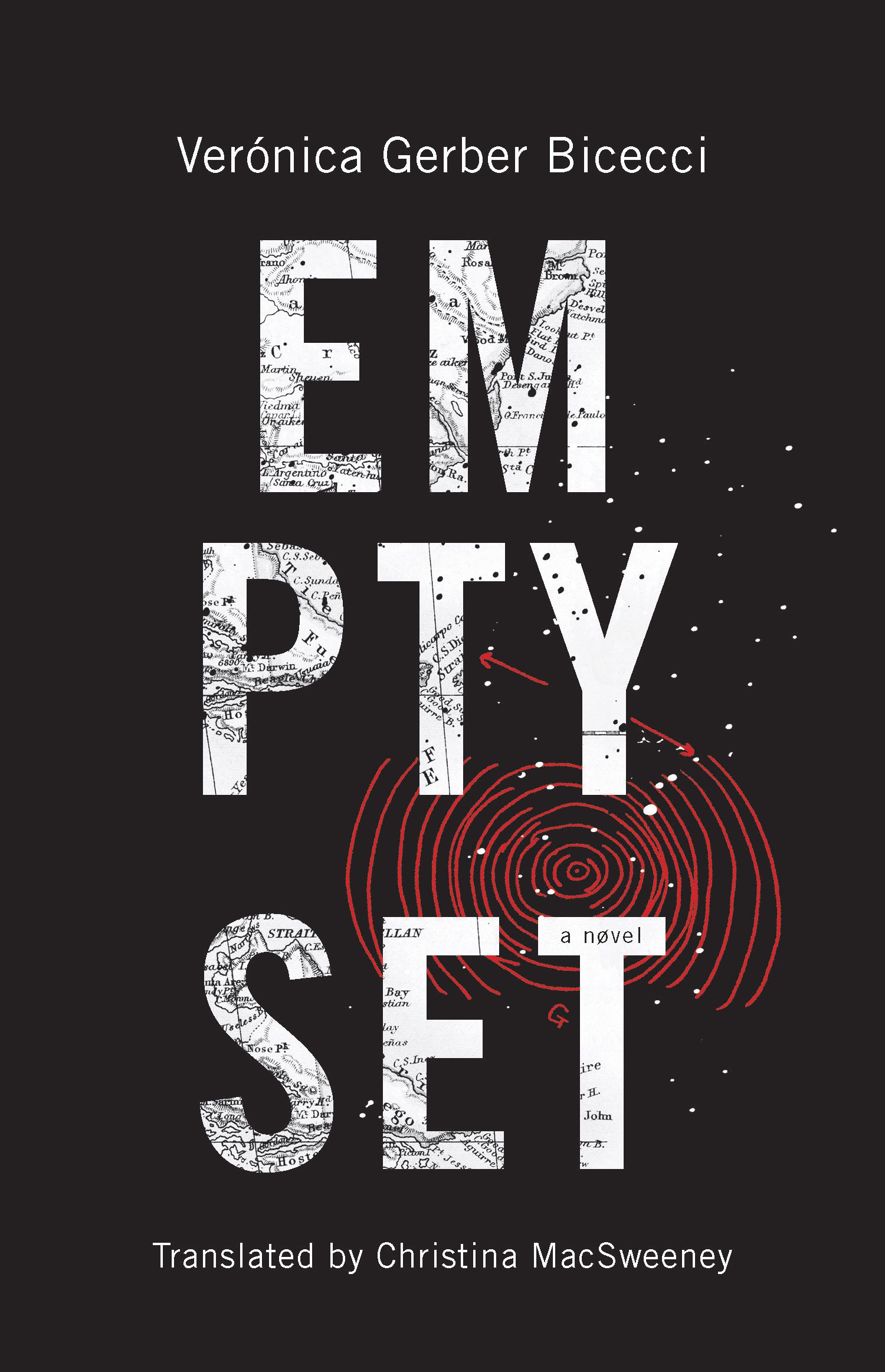The Rumpus Book Club chats with author Verónica Gerber Bicecci and translator Christina MacSweeney about the innovative novel, Empty Set (forthcoming from Coffee House Press on February 6, 2018), the collaborative process of translation, and why the book is “amphibian.”
This is an edited transcript of the book club discussion. Every month The Rumpus Book Club hosts a discussion online with the book club members and the author, and we post an edited version online as an interview. To become a member of the Rumpus Book Club, click here. Upcoming writers include Terese Mailhot, Jesse Ball, Melissa Broder, and more.
This Rumpus Book Club interview was edited by Marisa Siegel.
***
Marisa: Hi, and welcome to The Rumpus Book Club chat with author Verónica Gerber Bicecci and translator Christina MacSweeney about Empty Set!
Verónica Gerber Bicecci: Hey! I’m ready and very happy to chat with you!
Christina MacSweeney: Hi, Marisa. Just to let you know I’m online.
Marisa: I’m so glad you are both able to join us! Let’s get started, and hopefully some of our members will chime in.
Christina MacSweeney: Thank you for asking us!
Marisa: Verónica, your bio describes you as a visual artist who writes. How do you feel the two art forms interplay with each other in your work, and specifically, in Empty Set? Did you come first to visual art or to writing or has it always been both?
Verónica Gerber Bicecci: It has been always both. With Empty Set, I wanted to use drawings and text, trying not to convert drawings in illustrations but as part of the story.
Marisa: Did you work on the drawings as you worked on the text, or did you start with one first?
Verónica Gerber Bicecci: I have to let you know that I will make mistakes with my English, sorry for that in advance!
Marisa: Of course! Please don’t worry about it. If you need me to ask a question differently, just let me know.
Verónica Gerber Bicecci: I started writing but it was very soon when I felt the need of stopping words and go to my drawing table to start with other kind of lines. So, it was almost at the same time.
Verónica Gerber Bicecci: And then, it was coming and going from one table to the other!
Eva Woods: Hi! I had some trouble with the site.
Eva Woods: I love that we have a translator and an author at the same time!
Christina MacSweeney: Yes, we don’t always get to talk together like this.
Verónica Gerber Bicecci: Yes, it is great that Christina, who wrote this book in English, is here with us!
Marisa: Verónica, can you share where the inspiration for Empty Set came from? I noted the book is dedicated to your brother, and the protagonist shares your name. Are there other elements of autobiography in the book?
Verónica Gerber Bicecci: I would lie if I say it is all autobiography, but I’ll be lying too if I say that everything is fiction. It is amphibian.
Marisa: Very mysterious! Much like the book.
Marisa: Translation is always so interesting to think and talk about—walking a tightrope of staying true to the original text and making the text accessible to readers of another language. That seems especially daunting with a book like Empty Set.
Eva Woods: What I loved about the text is that as a reader, it was hard to wrap your head around what was reasonable and rational and what was part of the journey we were expected to do, personally.
Marisa: Christina, you’ve translated so many wonderful books. Can you tell us a bit about working on Empty Set?
Christina MacSweeney: Thanks, Marisa. I think that translation is less of a tightrope than a reaction to the original text, a means of finding a way through it. Working with text and drawings was something new for me, but it was great: sometimes I felt I was reading the text and looking at the drawings, and sometimes it was like reading the drawings and viewing the text.
Eva Woods: Marisa, I think that we’re having some trouble with the interface here, which has happened before, but this book makes it more relevant than in the past.
Eva Woods: In a way, it feels more appropriate that we are having technical problems.
Verónica Gerber Bicecci: Thank for joining Eva, and yes, I agree: technical problems is ad hoc to Empty Set and its journey.
Marisa: Christina and Verónica, how collaborative was the translation process for this book?
Christina MacSweeney: Hi Eva. Welcome to the chat. Any questions or comments?
Eva Woods: I’m with Marisa. The process between writing and translation is so important to me.
Christina MacSweeney: Very collaborative I would say. We talked about certain decisions right from the start. It has been a deeply interesting process and one I hope we can continue with other projects.
Eva Woods: Since this story was so articulate, did you worry that there would be a gap between what was written and what people read? I felt like, reading it, there was a barrier between emotion and prose.
Marisa: Yes, I was wondering something similar. The language and story leave much to the reader to fill in, and I wondered if you hoped readers would come away with one specific idea or each a different idea.
Christina MacSweeney: I think that gap is part of the nature of communication, something we are all trying to bridge with every articulation.
Eva Woods: This novel was so technical, but also so visceral.
Verónica Gerber Bicecci: It was a beautiful process. To me translation it is a process of creation, I wanted very much that Christina appropriate the text as much as possible and tried to comment to help in that appropriation process.
Eva Woods: How did you find each other, author and translator?
Verónica Gerber Bicecci: I agree with Christina. And would add that the language is technical, but many of the drawings wanted to be emotional.
Eva Woods: I am multilingual and when I write in one language I worry about how I’ll be portrayed.
Verónica Gerber Bicecci: I think it was thanks to Daniel Saldaña Paris, who talked to Christina about my book, and I’ll never forget to thank him for doing it!
Christina MacSweeney: I first heard of Verónica’s work from the author Daniel Saldaña París. He knew of my interest in the interface between the visual and writing in translation and suggested we get in touch. And yes: can’t thank him enough for that.
Eva Woods: One of the things that really (and I hope this comes across) hurt my feelings… is that you saw the space between you as an author and your characters was—we live in a middle space.
Marisa: This felt much closer to reading poetry than fiction, for me (a poet).
Verónica Gerber Bicecci: Many poets have told me that, and it is great because it helps to the amphibian nature of the book.
Eva Woods: If you study science, you see yourself as an outside force. But this work doesn’t allow you to do that.
Verónica Gerber Bicecci: Eva: could you elaborate a bit more about what hurt your feelings? I’m very interested but not sure if I’m understanding completely.
Eva Woods: It was hard for me to balance my feelings for the characters with my own pride.
Marisa: Can you talk a little about the Email Set at the end of the book, Christina? I loved that it put you in the story, too. The translator isn’t usually made visible in this way.
Eva Woods: Marisa, I agree.
Marisa: And I’m wondering if Verónica was a part of the idea of Email Set?
Christina MacSweeney: I’m glad you liked that Marisa. Yes, it is slightly unusual for translators to have this sort of visibility, but I hope it happens more. It really came about because we thought readers might be interested in how we came to certain decisions during the translation, the sort of process we went through. I also thought it was wonderful that Verónica agreed to create new drawings for that part of the text, so that it merged into the novel as a whole. Hopefully it will give readers some insight also into the collaborative nature of any translation.
Verónica Gerber Bicecci: Email Set was Christina’s idea, I think. She asked me to do the drawings as part of our conversations. And I’m very happy about it because I feel this book has now shared custody and this was somehow a statement to make that as clear as possible.
Christina MacSweeney: Yes, it definitely feels like shared custody! And that involves a lot of generosity on Verónica’s part.
Eva Woods: What hurt my feelings is that I felt the action of being analytical was maybe looked on as lesser? If that’s unfair, feel free to correct me, but I felt while reading Empty Set that emotion was prized over… I don’t know? Reticence?
Marisa: That’s interesting, Eva, because I thought the book was doing the opposite: putting analytical, logical thought above emotion, or somehow situating it as more “correct” than emotional thought.
Marisa: And because I know Eva personally, I can also share that I find it especially interesting that we each thought these things, as I am much more emotional and Eva is much more analytical, at least at face value.
Christina MacSweeney: When I first read the Spanish, I was very drawn to the way the emotional and analytical elements interacted. I didn’t myself feel there was a hierarchy.
Eva Woods: And I should also say that this felt like the first novel I’ve ever read that plumbed emotion like it was a fault, like we were being asked to interrogate ourselves as though we were platonic plates.
Marisa: I think what I saw was a woman—the protagonist—trying to impose order using science and analytical thinking, to get ahold of her emotions around trauma she had experienced.
Verónica Gerber Bicecci: Once a kindergarten professor told me that she experienced a cognitive shock while reading Empty Set. I liked that idea very much: she said emotional and analytical seem to be somehow misplaced and that’s what make her to feel in shock. I don’t know if this lights a candle on that.
Marisa: Verónica, who are your favorite artists? Is Empty Set inspired by any existing written work or visual art?
Eva Woods: Marisa and I have been hoping and waiting for an author and translator to join us here, and I would love to know: what were your biggest fights?!
Marisa: Oh, that’s a good question, Eva! I’d love to hear about disagreements and how you work through them.
Christina MacSweeney: Marisa, I hate to tell you this, but I don’t remember any fights! We talk things through from different angles, listen to one another’s opinions. But on the whole, we mostly seem to come at things from the same direction.
Eva Woods: Somehow, you’ve brought together a work of fiction, but WOW I can’t imagine doing that.
Verónica Gerber Bicecci: About the artists: all of the ones that you see in the exhibition passage, to start. With those I’ve had lots of conversations through their works and books.
Verónica Gerber Bicecci: I don’t remember fights either! How boring we are! Haha.
Eva Woods: I think it’s incredible that you have been through this process without fighting!
Christina MacSweeney: In response to Verónica: I have also become very interested in the work of the artists she mentioned, and looking at their work was part of the translation process.
Marisa: Verónica, it almost felt like you were leaving clues for a reader (books and artists mentioned, time jumps, certain memories revealed while others are not), but I’m wondering what you hope readers will take away overall from the stories within Empty Set?
Eva Woods: What I would love to hear from you, Veronica, is how you conceived of the structure. To me, that’s the hardest part of the story, but it seemed effortless.
Verónica Gerber Bicecci: Yes, you’re right, the book is full of clues. It is difficult to say one thing I was hoping readers will take away but think I wanted them to find other ways of reading. But hopefully readers will find things I can’t see.
Verónica Gerber Bicecci: Well, I’m happy to hear it feels natural; it was very hard to get to the structure I wanted!
Eva Woods: There were many times I felt nervous that the plot would get lost because we were supposed to be following a path. But you kept the characters so invested, we stayed on board. How did you engineer that?
Marisa: Reading Empty Set is certainly a different experience than reading most books, and I felt very involved in the story.
Verónica Gerber Bicecci: It was a four-year process. I write in the computer and draw in a big notebook and scan drawings. I printed several times every page and set them in the living room to play with them until I found the “order.” I did and redid drawings and words many, many times until it felt it was right.
Verónica Gerber Bicecci: The idea is that you come and go in the book. You see a page you don’t understand, you go on and then something happens so you go back and now you can see in a drawing what you couldn’t see before. And everything changes. (Well, this is how I thought it—you are the ones to say if this happens or not!)
Marisa: That is exactly what happened! On some pages, I felt very lost. But I’d keep reading, and then go back, and “Aha, now I see” about that page that had confused me.
Eva Woods: Do you ever worry that you’re going to lose the feeling in your diagrams?
Verónica Gerber Bicecci: I worried about everything all the time. With the diagrams, I was worried that the drawings couldn’t tell the parts of the story they’re supposed to tell.
Eva Woods: Reading it I wondered how you could be brave enough to put your character’s selves in math, if that makes sense?
Eva Woods: Like I worried they could get lost in the structure of themselves.
Christina MacSweeney: One of the things I loved was that moving back and forth between drawings and text at different stages of the reading (and translation) so that I was constantly reevaluating what was happening in the book.
Eva Woods: I love this, because it’s the constant re-challenging of your own characters.
Verónica Gerber Bicecci: Well, yes, you’re right, Eva, for me the risk was to make readers to be moved by a “math” diagram.
Eva Woods: Verónica, I love the parentheses around “math.”
Eva Woods: Because you didn’t bracket it; you didn’t even use it in a way most people would understand. You just suggested that story and character could be corralled by it.
Marisa: We are almost at the end of the hour. What is next for each of you? Christina, are you working on any translations you can share news about? Verónica, do you have a new project already? And do you two think you will collaborate again?
Christina MacSweeney: I have a book by another Mexican author, Julián Herbert, coming out just after Verónica’s Empty Set, and Verónica and I have started working on her essay, “Mudanza (Moving Out),” which I adore, so hopefully we will see that in English soon!
Verónica Gerber Bicecci: And we also collaborated in this project in April 2017.
Marisa: I’m so glad we will see more from the two of you in collaboration! Thank you both for being part of this conversation, and for creating this fascinating book. It’s really unlike anything I’ve read before, and I’m so glad Coffee House is putting it out into the world.
Eva Woods: Thank you so much for your time!
Christina MacSweeney: Thank you both for your interest and appreciation.
Verónica Gerber Bicecci: Thanks to you for this conversation and your questions, a big hug!







